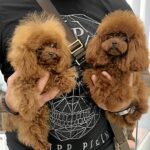Red (Toy) Poodle
People love small animals; their tiny size fills us with affection. However, they grow quickly, and the magic of their smallness fades. The desire for these adorable creatures to remain miniature forever has led to attempts at creating tiny dog breeds. Thankfully for enthusiasts of miniature pets, these attempts have often been successful. Many popular pets now have miniature versions.
Dogs are no exception, and this applies particularly to the poodle—a highly sought-after and beloved breed due to its exceptional qualities. Poodles are prized not only for their intelligence but also for their cheerful and lively temperament, as well as their strong attachment to their owners, making them ideal family dogs.
The existence of four variations of the poodle breed—standard (large), medium, and the decorative toy poodle—is a testament to this. The history of the small toy poodle is fascinating and proves that human preferences have remained consistent over the centuries.
Origin
The miniature poodle has existed for about 500 years. During the 17th and 18th centuries, the breed became popular among aristocrats, who desired even smaller versions of the mini poodle. This led to the creation of the Toy Poodle, which is also known by several other names.
The name “poodle” itself comes from the German word for “splashing in water,” as the dog was originally used for hunting waterfowl. The standard poodle is a water retriever, which was highly popular and is the ancestor of both the mini and toy poodle.
The toy poodle reached its modern standards at the beginning of the 20th century. Breeders reduced the size of the face, and while the dog lost its hunting instincts, it retained its high level of intelligence.
Nutrition
Since toy poodles are prone to autoimmune diseases, they should not be fed fatty foods. If you prefer feeding your toy poodle natural products, suitable options include chicken, turkey, beef, and lamb. Their diet can be supplemented with cooked boneless seafood. Vegetables are also suitable, except for potatoes and legumes. Yogurt should have a low fat percentage, while rice and buckwheat are allowed. Vitamins and minerals, especially biotin (essential for coat formation), are necessary supplements. Access to clean, fresh water should always be available.
Training
Toy poodles excel at learning commands, and their intelligence often earns them a place in circus performances. With proper training, they can become athletes, watchdogs, or even hunters. They are also excellent at navigating obstacle courses at high speed and can become champions in such activities.
Temperament
These small dogs are very delicate, so children should be taught how to handle them gently. Being social and active, toy poodles can become destructive if left alone for long periods. Providing toys can help prevent damage to furniture.
What else should we know about the toy poodle’s personality? With proper care and training, toy poodles grow up to be polite, good-natured, curious, and sociable. Regarding interactions with other pets, this little dog is considered a "canine psychologist," reacting immediately to changes in mood. It is friendly with other animals but will not tolerate being dominated. However, individual personalities vary—some toy poodles may be proud and reserved, while others are gentle and affectionate.
Care
Since the texture of their coat is similar to human hair, toy poodles can be bathed regularly. Cleaning their eyes and ears should also be part of their routine care, as with any dog. Using conditioners to strengthen the coat is recommended. Essential grooming tools include a furminator, a brush for detangling, and a moisturizing spray to prepare the coat before brushing.
At home, care involves providing a comfortable sleeping area. Outdoors, toy poodles require daily walks twice a day. Despite their miniature size, they need at least two hours of walks and playtime daily.
източник: miau.bg




